Exercise(Linked Comprehension ) from CENGAGE CHEMISTRY Chapter 16 ELECTROCHEMISTRY for Class 12
| Class 12 | CHEMISTRY |
| Chapter | ELECTROCHEMISTRY |
| CENGAGE CHEMISTRY | Exercise(Linked Comprehension ) |
| Medium | English |
| Academic Year | 2023-2024 |
Question 1
An aqueous solution containing 0.1MFe3+ and 0.01MFe2+ was titrated with a concentrated solution of NaOH at 30∘C , so that changes in volumes were negligible. Assuming that the new species formed during titration are Fe(OH)3 and Fe(OH)2 only.
Given Ec−.Fe3+∣Fe2+=0.80V,
KspFe(OH)3=10−37, and KspFe(OH)2=10−19
The redox potential of Fe3+∣Fe2+ electrode at pH=6 isView SolutionQuestion 2
An aqueous solution containing 0.1MFe3+ and 0.01MFe2+ was titrated with a concentrated solution of NaOH at 30∘C , so that changes in volumes were negligible. Assuming that the new species formed during titration are Fe(OH)3 and Fe(OH)2 only.
Given Ec−.Fe3+∣Fe2+=0.80V,
KspFe(OH)3=10−37, and KspFe(OH)2=10−19
The redox potential of Fe3+∣Fe2+ electrode at pH=6 isView SolutionQuestion 3
An aqueous solution containing 0.1MFe3+ and 0.01MFe2+ was titrated with a concentrated solution of NaOH at 30∘C , so that changes in volumes were negligible. Assuming that the new species formed during titration are Fe(OH)3 and Fe(OH)2 only.
Given Ec−.Fe3+∣Fe2+=0.80V,
KspFe(OH)3=10−37, and KspFe(OH)2=10−19
The redox potential of Fe3+∣Fe2+ electrode at pH=6 isView SolutionQuestion 9
The magnitude ( but not the sign ) of the standard reduction potentials of two metals X and Y are :
Y2+2e−→Y∣∣Ec−1∣∣=0.34V
X2+2e−→X∣∣Ec−2∣∣=0.25V
When the two half cells of X and Yare connected to construct a cell, eletrons flow from X to Y. When X is connected to a standard hydrogen electrode (SHE),electrons flow from X to SHE.
If a half call X∣X2(0.1M) is connected to another half cell Y∣Y2+(1.0M) by means of a salt bridge and an external circuit at 25∘C, the cell voltage would be View SolutionQuestion 10
The magnitude ( but not the sign ) of the standard reduction potentials of two metals X and Y are :
Y2+2e−→Y∣∣Ec−1∣∣=0.34V
X2+2e−→X∣∣Ec−2∣∣=0.25V
When the two half cells of X and Yare connected to construct a cell, eletrons flow from X to Y. When X is connected to a standard hydrogen electrode (SHE),electrons flow from X to SHE.
If standard emf (Ec−) of a half cell Y2∣Y⊕ is 0.15V, the standard emf of the half cell Y⊕∣Y will be View SolutionQuestion 11
The magnitude ( but not the sign ) of the standard reduction potentials of two metals X and Y are :
Y2+2e−→Y∣∣Ec−1∣∣=0.34V
X2+2e−→X∣∣Ec−2∣∣=0.25V
When the two half cells of X and Yare connected to construct a cell, eletrons flow from X to Y. When X is connected to a standard hydrogen electrode (SHE),electrons flow from X to SHE.
Given the following half cell :YI+e−→Y−Ic−: Ec−=−0.27V
Solubility product of the iodide salt YI is View SolutionQuestion 12
A volataic cell consists of an electode of solide silver immerse in a 0.10MAgNO3 solution and an electrode of unknown metal 'X' immersed in a 0.10M solution X(NO3)2. A porous barrier separates the two half of the cell. Also given :
Ec−.(Ag⊕∣Ag)=0.80V and Ec−.cell=1.05V at 25∘C
X(s)∣∣X2+(1.0M)∣∣∣∣Ag⊕(0.1M)∣∣Ag(s)
Which of the following statements regarding the cell and X is incorrect?View SolutionQuestion 13
A volataic cell consists of an electode of solide silver immerse in a 0.10MAgNO3 solution and an electrode of unknown metal 'X' immersed in a 0.10M solution X(NO3)2. A porous barrier separates the two half of the cell. Also given :
Ec−.(Ag⊕∣Ag)=0.80V and Ec−.cell=1.05V at 25∘C
X(s)∣∣X2+(1.0M)∣∣∣∣Ag⊕(0.1M)∣∣Ag(s)
If Ag⊕∣Ag half cell in the above voltaic cell is replaced by Zn2+∣Zn half cell (Ec−.Zn2+∣Zn=−0.76V)View SolutionQuestion 14
Fuel cells : Fuel cells are galvanic cells in which the chemical energy of fuel cell is directly converted into electrical energy. A type of fuel cell is a hydrogen − oxygen fuel cell. It consists of two electrodes made up of two porous graphite impregnated with a catalyst ( platinum, silver, or metal oxide ). The electrodes are placed in aqueous solution of NaOH . Oxygen and hydrogen are continuously fed into the cell. Hydrogen gets oxidized to H⊕ which is neutralized by c−OH,i.e., anodic reaction.
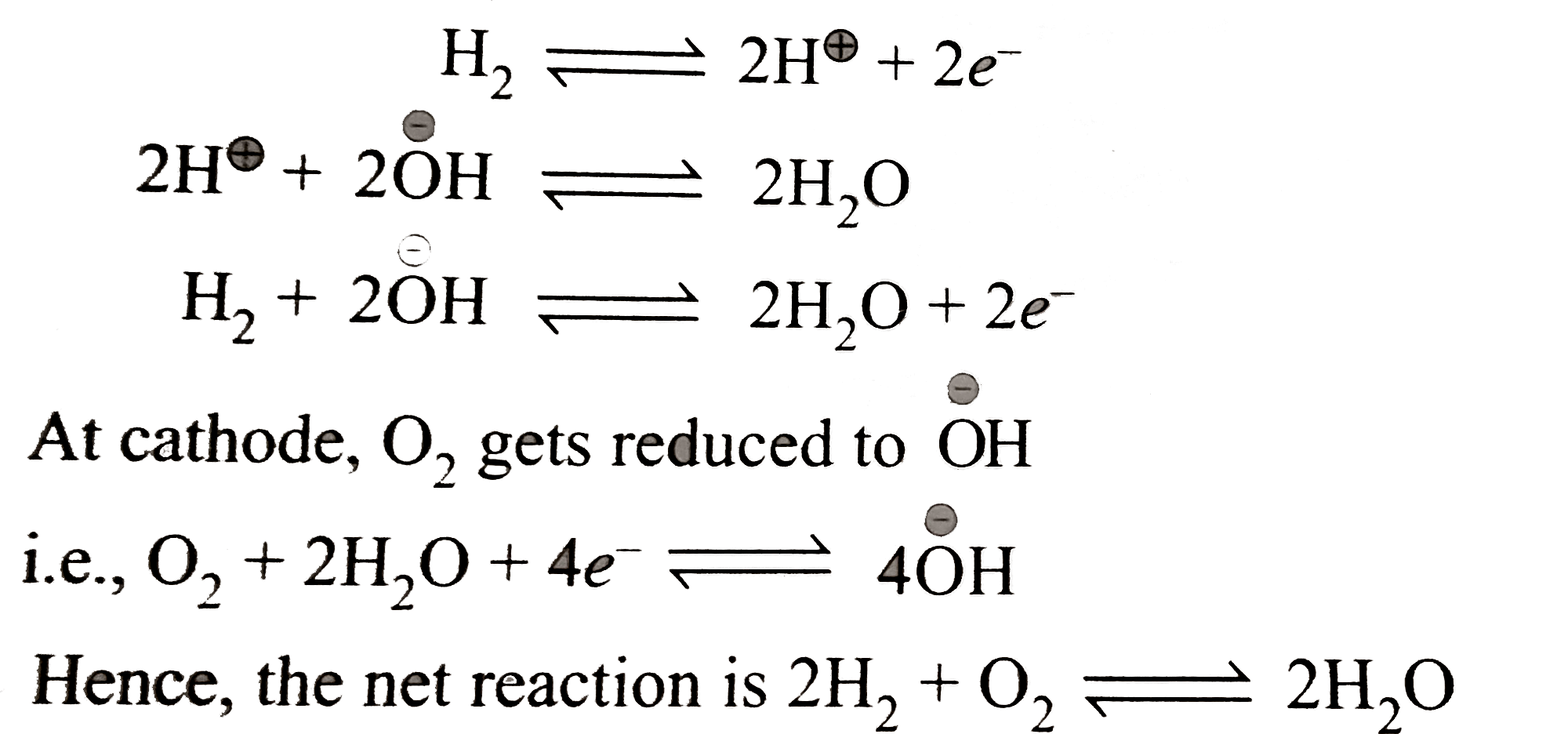
At cathode, O2 gets reduced to c−OH

Hence, the net reaction is
The overall reaction has
ΔH=−285.6kJmol−1 and ΔG=−237.4kJmol−1 at 25∘C
If the cell voltage is 1.23V for the H2−O2 fuel cell and for the half cell : View SolutionQuestion 15
Fuel cells : Fuel cells are galvanic cells in which the chemical energy of fuel cell is directly converted into electrical energy. A type of fuel cell is a hydrogen − oxygen fuel cell. It consists of two electrodes made up of two porous graphite impregnated with a catalyst ( platinum, silver, or metal oxide ). The electrodes are placed in aqueous solution of NaOH . Oxygen and hydrogen are continuously fed into the cell. Hydrogen gets oxidized to H⊕ which is neutralized by c−OH,i.e., anodic reaction.
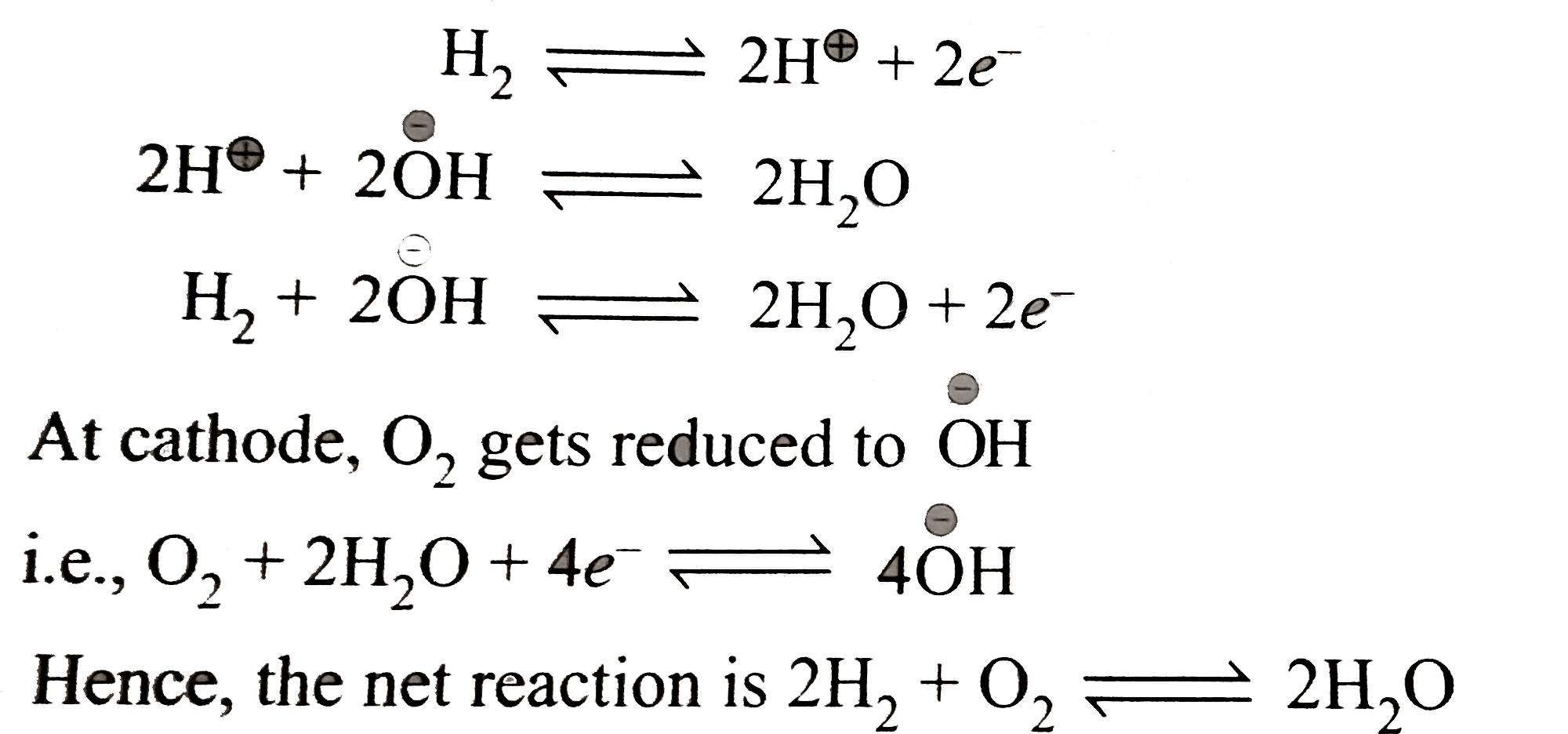
At cathode, O2 gets reduced to c−OH
Hence, the net reaction is
The overall reaction has
ΔH=−285.6kJmol−1 and ΔG=−237.4kJmol−1 at 25∘C
What is the value of ΔSc− for the fuel cell at 25∘C?View SolutionQuestion 16
Fuel cells : Fuel cells are galvanic cells in which the chemical energy of fuel cell is directly converted into electrical energy. A type of fuel cell is a hydrogen − oxygen fuel cell. It consists of two electrodes made up of two porous graphite impregnated with a catalyst ( platinum, silver, or metal oxide ). The electrodes are placed in aqueous solution of NaOH . Oxygen and hydrogen are continuously fed into the cell. Hydrogen gets oxidized to H⊕ which is neutralized by c−OH,i.e., anodic reaction.
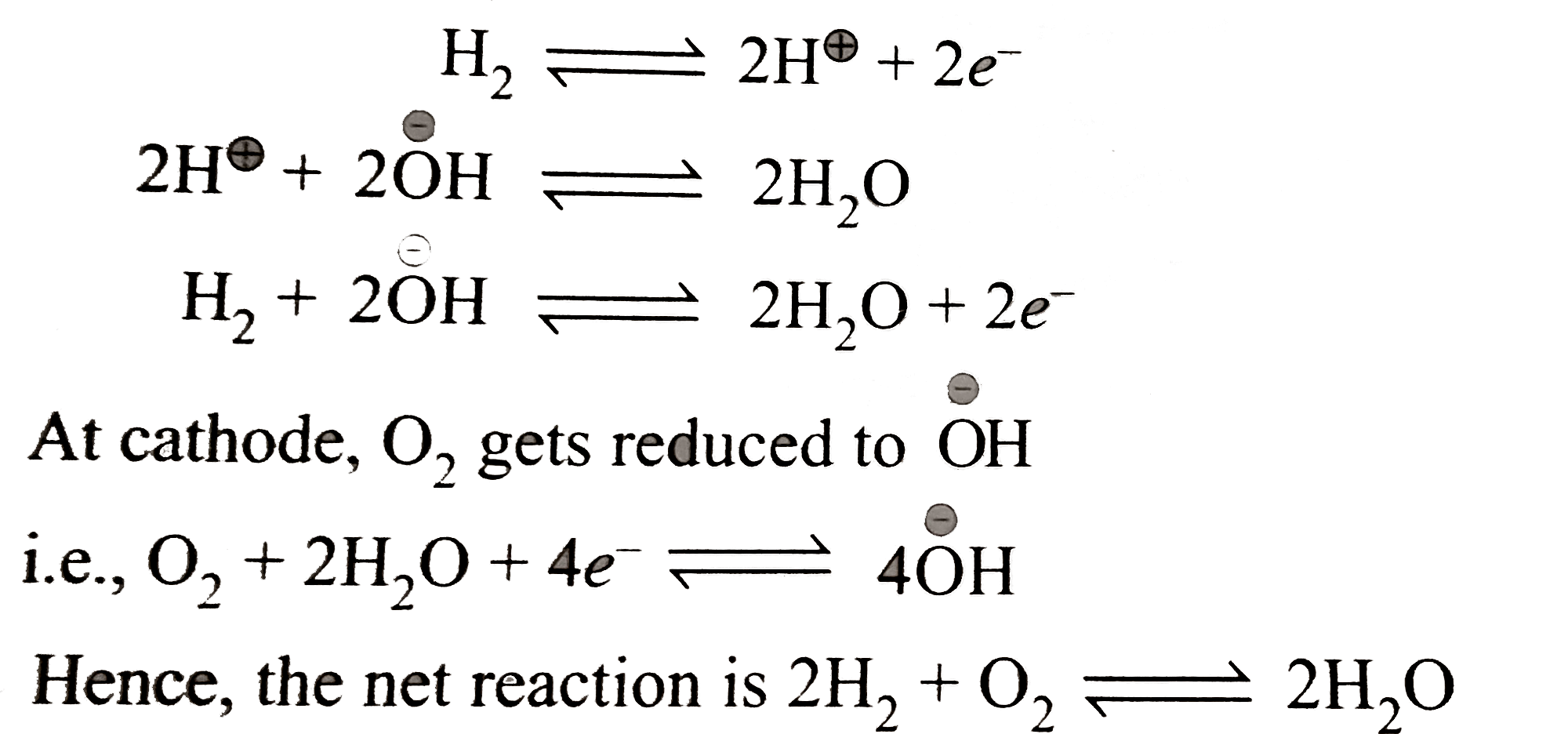
At cathode, O2 gets reduced to c−OH
Hence, the net reaction is
The overall reaction has
ΔH=−285.6kJmol−1 and ΔG=−237.4kJmol−1 at 25∘C
Suppose the concentration of hydroxide ioin in the cell is doubled, then the cell voltage will be View SolutionQuestion 17
Fuel cells : Fuel cells are galvanic cells in which the chemical energy of fuel cell is directly converted into electrical energy. A type of fuel cell is a hydrogen − oxygen fuel cell. It consists of two electrodes made up of two porous graphite impregnated with a catalyst ( platinum, silver, or metal oxide ). The electrodes are placed in aqueous solution of NaOH . Oxygen and hydrogen are continuously fed into the cell. Hydrogen gets oxidized to H⊕ which is neutralized by c−OH,i.e., anodic reaction.
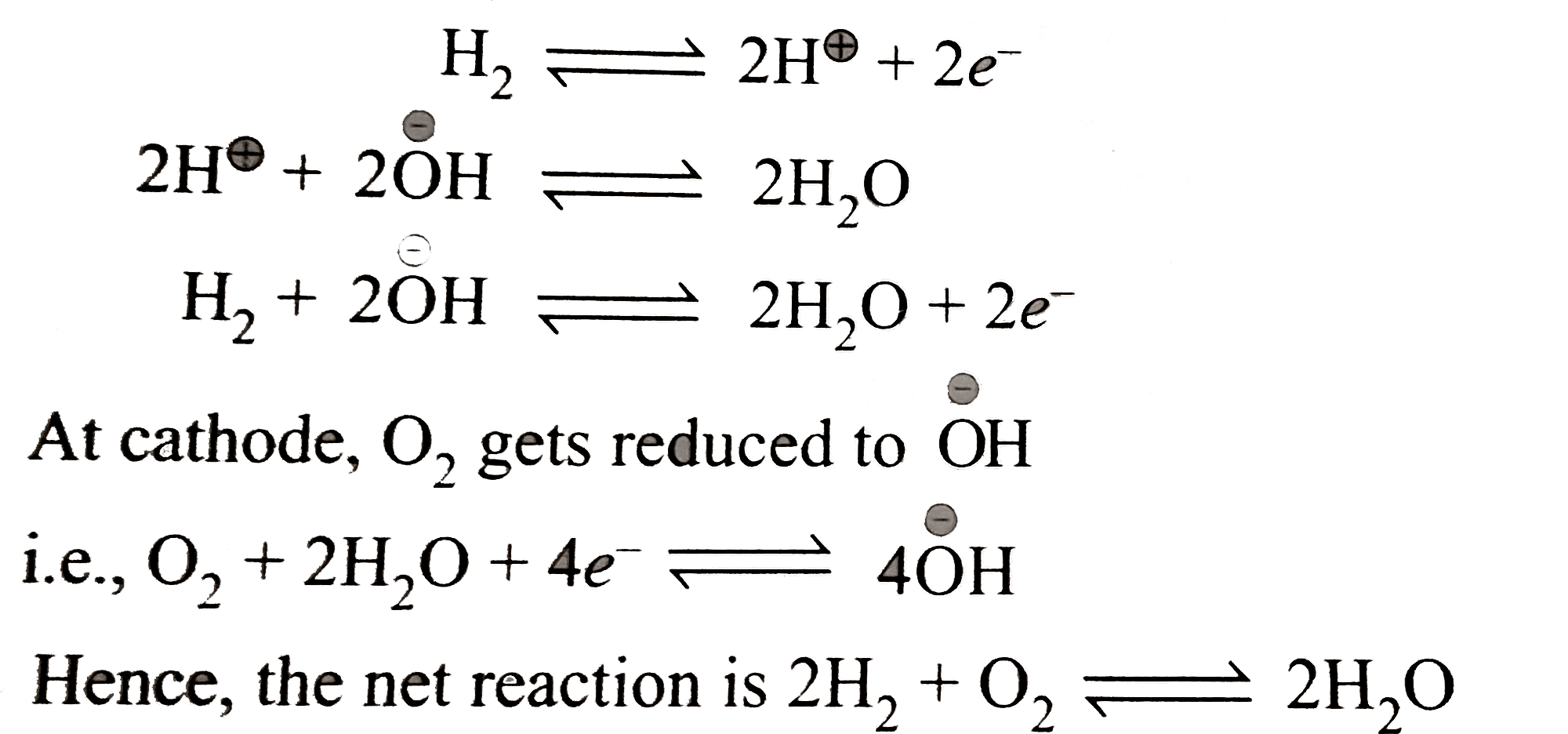
At cathode, O2 gets reduced to c−OH
Hence, the net reaction is
The overall reaction has
ΔH=−285.6kJmol−1 and ΔG=−237.4kJmol−1 at 25∘C
A fuel cell is
I. A voltaic cell in which continuous supply of fuels are sent at anode to perform oxidation.
II. A voltaci cell in which fuels such as :CH4,H2, and CO are used up at anode.
III. One which involves the reaction of H2−O2 fuel cell such as :
Anode :2H2O+4c−OH→4H2O(l)+4ec−
Cathode :O2+2H2O(l)=4e−→4c−OH
IV. The efficiency of H2−O20 fuel cell is 70 to 75%View SolutionQuestion 18
A conductivity cell is used to measure the conductance of electrolyte . It makes use of conductivity of water which does not contain any ions. The cell constant of conductivity cell is determined.
If the cell constant is 0.40cm−1, the conductivity of 0.051MNaCl solution having R=1850ohm is equal to View SolutionQuestion 19
A conductivity cell is used to measure the conductance of electrolyte . It makes use of conductivity of water which does not contain any ions. The cell constant of conductivity cell is determined.
Calculate α of CH3COOH if Δ∞.m for HCl,NaCl,CH3COOHNa are 426,126,91Scm2mol−1, respectively, and ∧m=14.4Scm2mol−1 at 0.015M concentration. View SolutionQuestion 20
Breathalyzer is used to detect the alcohol content in the suspected drunk drivers. The ethanol in the exhaled breath is oxidized to ethanoic acid with an acidic solution of K2Cr2O7 as follows :
3CH3CH2OH(aq)Ehanol+2Cr2O2−7(aq)+16H⊕(aq)→3CH3COH(aq)Ethanoicacid+4Cr3+(aq)+11H2O(l)
The breathalyzer measures the colour change and produces a metre reading calibrated in the terms of blood alcohol content.
If Ec−.CH3COOH∣C2H5OH=0.06V and Ec−.Cr2O2−7∣Cr3+=1.33V,
then Ec−.cell of the reaction taking place in alcohol metre is View SolutionQuestion 21
Breathalyzer is used to detect the alcohol content in the suspected drunk drivers. The ethanol in the exhaled breath is oxidized to ethanoic acid with an acidic solution of K2Cr2O7 as follows :
3CH3CH2OH(aq)Ehanol+2Cr2O2−7(aq)+16H⊕(aq)→3CH3COH(aq)Ethanoicacid+4Cr3+(aq)+11H2O(l)
The breathalyzer measures the colour change and produces a metre reading calibrated in the terms of blood alcohol content.
Colour of the testing solution changes from View SolutionQuestion 22
Breathalyzer is used to detect the alcohol content in the suspected drunk drivers. The ethanol in the exhaled breath is oxidized to ethanoic acid with an acidic solution of K2Cr2O7 as follows :
3CH3CH2OH(aq)Ehanol+2Cr2O2−7(aq)+16H⊕(aq)→3CH3COH(aq)Ethanoicacid+4Cr3+(aq)+11H2O(l)
The breathalyzer measures the colour change and produces a metre reading calibrated in the terms of blood alcohol content.
The EMF of the reaction when the concentration of all the species are 1.0M and pH is 4.0 is View SolutionQuestion 23
Breathalyzer is used to detect the alcohol content in the suspected drunk drivers. The ethanol in the exhaled breath is oxidized to ethanoic acid with an acidic solution of K2Cr2O7 as follows :
3CH3CH2OH(aq)Ehanol+2Cr2O2−7(aq)+16H⊕(aq)→3CH3COH(aq)Ethanoicacid+4Cr3+(aq)+11H2O(l)
The breathalyzer measures the colour change and produces a metre reading calibrated in the terms of blood alcohol content.
What is the ethanol ethanoic acid ratio if the breathalyzer records 1.33V and other species are at 1M? View SolutionQuestion 24
A cell, as shown below, consists of there compartments separated by porous pots. The first contains a cobalt eletrode in 5.0L of 0.10MCo(NO3), the second contains 5.0L of 0.10MKNO3, the third contains an Ag electrode in 5.0L of 0.10MAgNO3. Assuming that current with in the cell iis carried equally by the negative and positive ions by passign 0.1F of electricity.

Given :Co2++2e−→Co Ec−=−0.28V
Ag^(o+)+e^(-) rarr Ag" "E^(c-)=0.80V<br>2Ag^(o+)+Corarr Co^(2+)+2Ag" "E^(c-)._(cell)=1.08V<br>F∈ally,theIcompartmentconta∈s<br>I. Co^(2+)" "II. NO_(3)^(c-)" "III.K^(o+)" "IV.Ag^(o+) View SolutionQuestion 25
A cell, as shown below, consists of there compartments separated by porous pots. The first contains a cobalt eletrode in 5.0L of 0.10MCo(NO3), the second contains 5.0L of 0.10MKNO3, the third contains an Ag electrode in 5.0L of 0.10MAgNO3. Assuming that current with in the cell iis carried equally by the negative and positive ions by passign 0.1F of electricity.
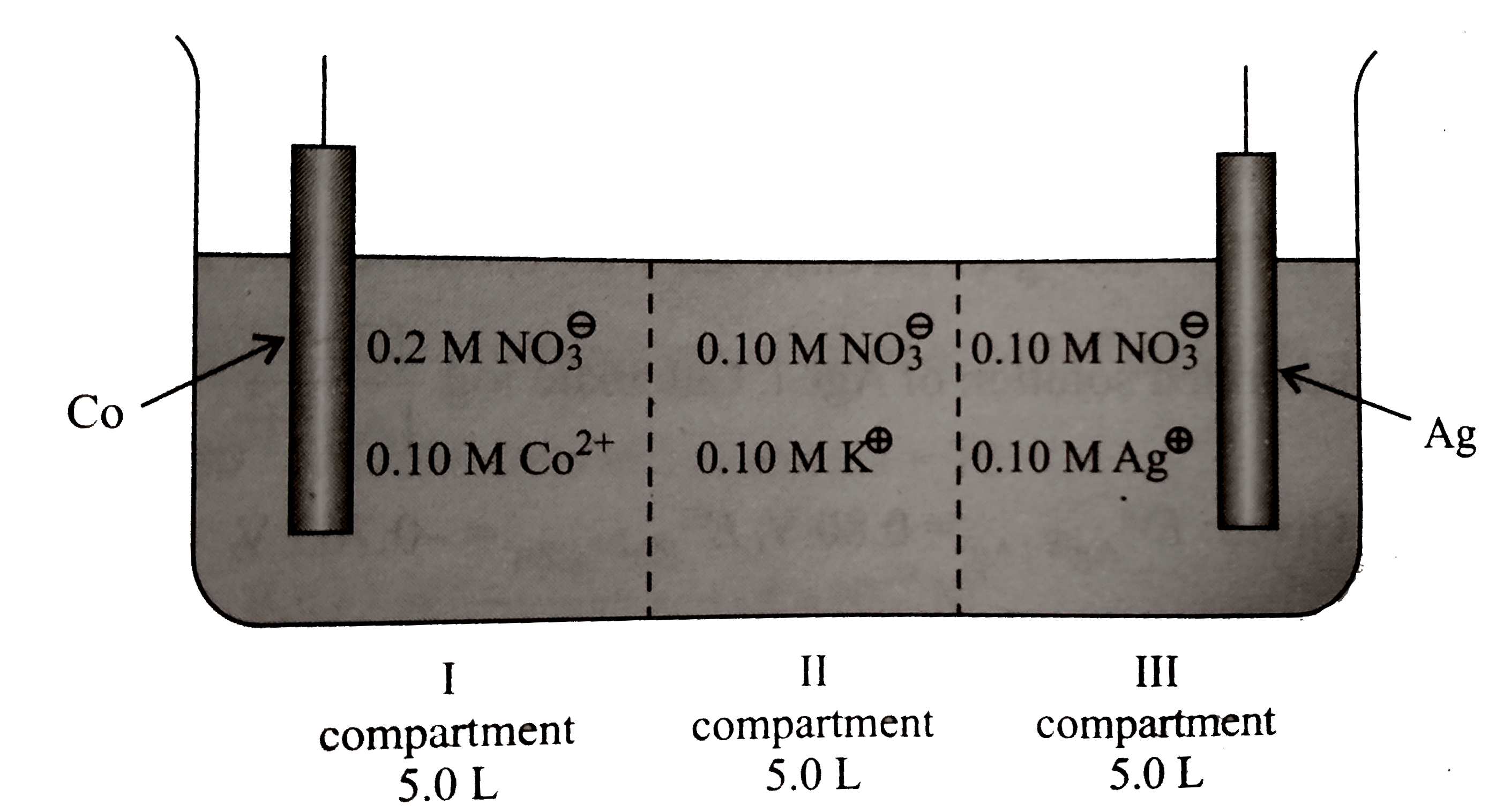
Given :Co2++2e−→Co Ec−=−0.28V
Ag^(o+)+e^(-) rarr Ag" "E^(c-)=0.80V<br>2Ag^(o+)+Corarr Co^(2+)+2Ag" "E^(c-)._(cell)=1.08V<br>F∈ally,theII compartment containsView SolutionQuestion 26
A cell, as shown below, consists of there compartments separated by porous pots. The first contains a cobalt eletrode in 5.0L of 0.10MCo(NO3), the second contains 5.0L of 0.10MKNO3, the third contains an Ag electrode in 5.0L of 0.10MAgNO3. Assuming that current with in the cell iis carried equally by the negative and positive ions by passign 0.1F of electricity.
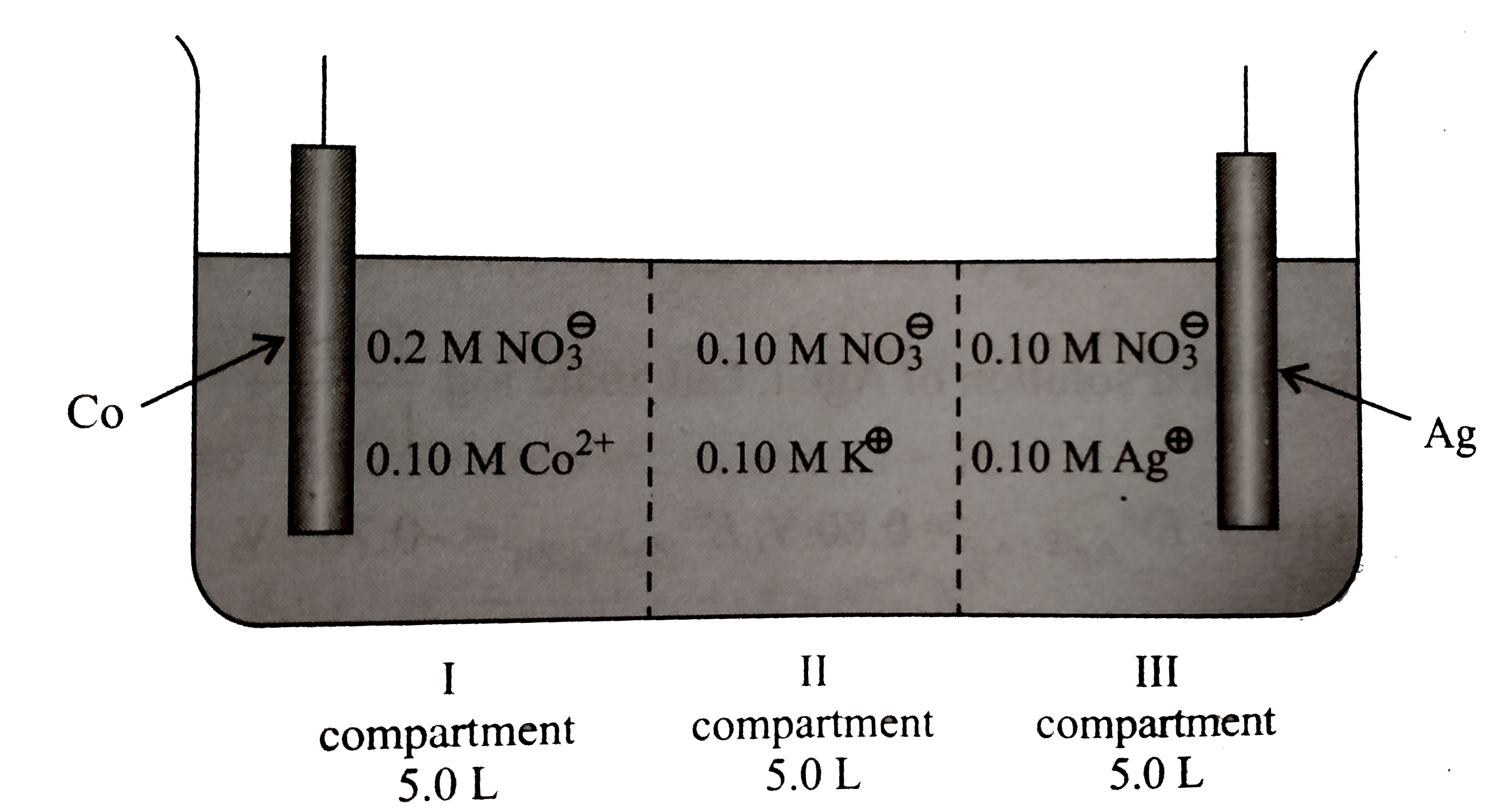
Given :Co2++2e−→Co Ec−=−0.28V
Ag^(o+)+e^(-) rarr Ag" "E^(c-)=0.80V<br>2Ag^(o+)+Corarr Co^(2+)+2Ag" "E^(c-)._(cell)=1.08V<br>F∈allytheII compartment containsView SolutionQuestion 27
A cell, as shown below, consists of there compartments separated by porous pots. The first contains a cobalt eletrode in 5.0L of 0.10MCo(NO3), the second contains 5.0L of 0.10MKNO3, the third contains an Ag electrode in 5.0L of 0.10MAgNO3. Assuming that current with in the cell iis carried equally by the negative and positive ions by passign 0.1F of electricity.
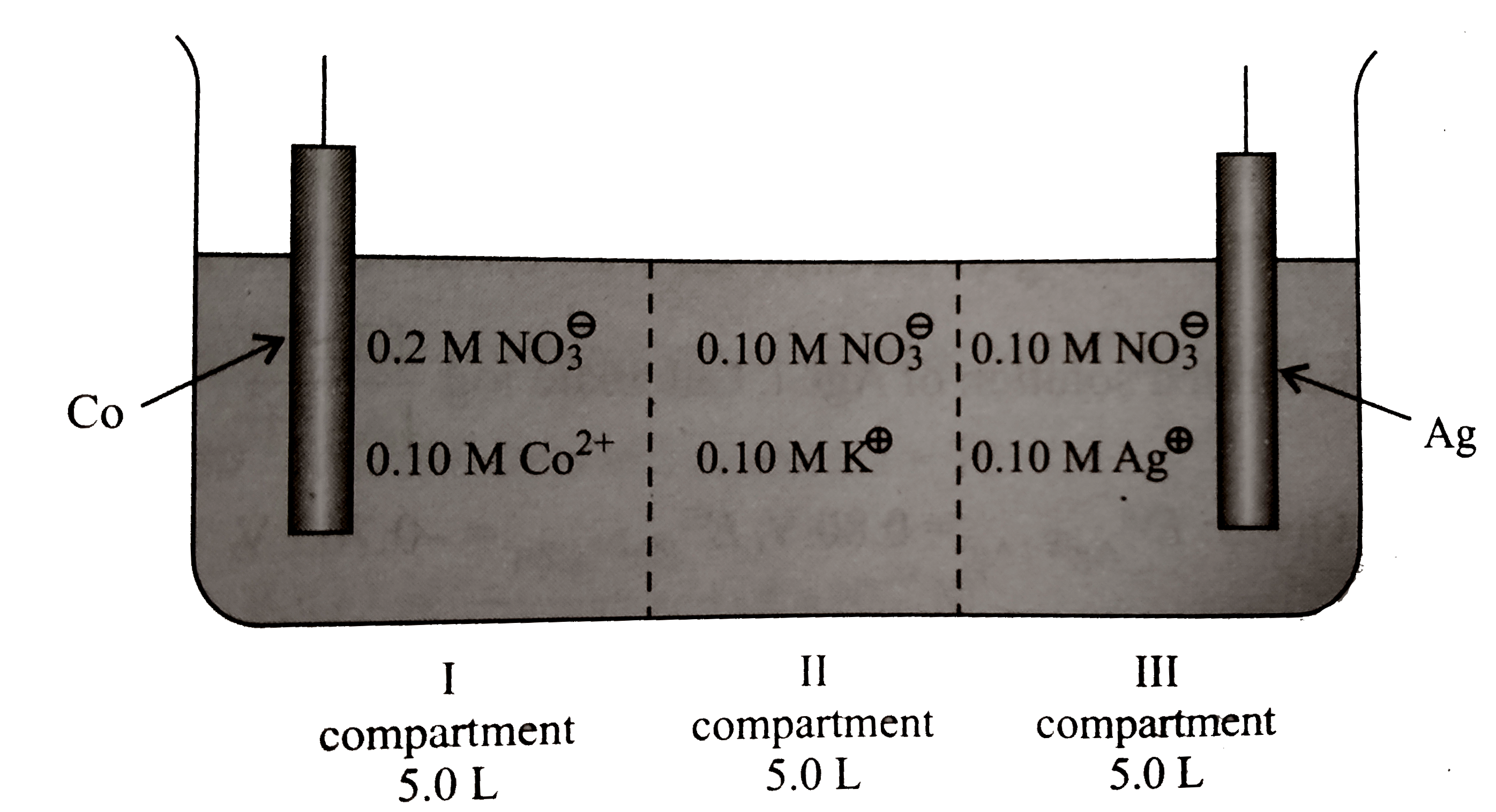
Given :Co2++2e−→Co Ec−=−0.28V
Ag^(o+)+e^(-) rarr Ag" "E^(c-)=0.80V<br>2Ag^(o+)+Corarr Co^(2+)+2Ag" "E^(c-)._(cell)=1.08V<br>Thef∈alconcentrationofCo^(2+)∈I, II, andIII compartment is View SolutionQuestion 28
A cell, as shown below, consists of there compartments separated by porous pots. The first contains a cobalt eletrode in 5.0L of 0.10MCo(NO3), the second contains 5.0L of 0.10MKNO3, the third contains an Ag electrode in 5.0L of 0.10MAgNO3. Assuming that current with in the cell iis carried equally by the negative and positive ions by passign 0.1F of electricity.
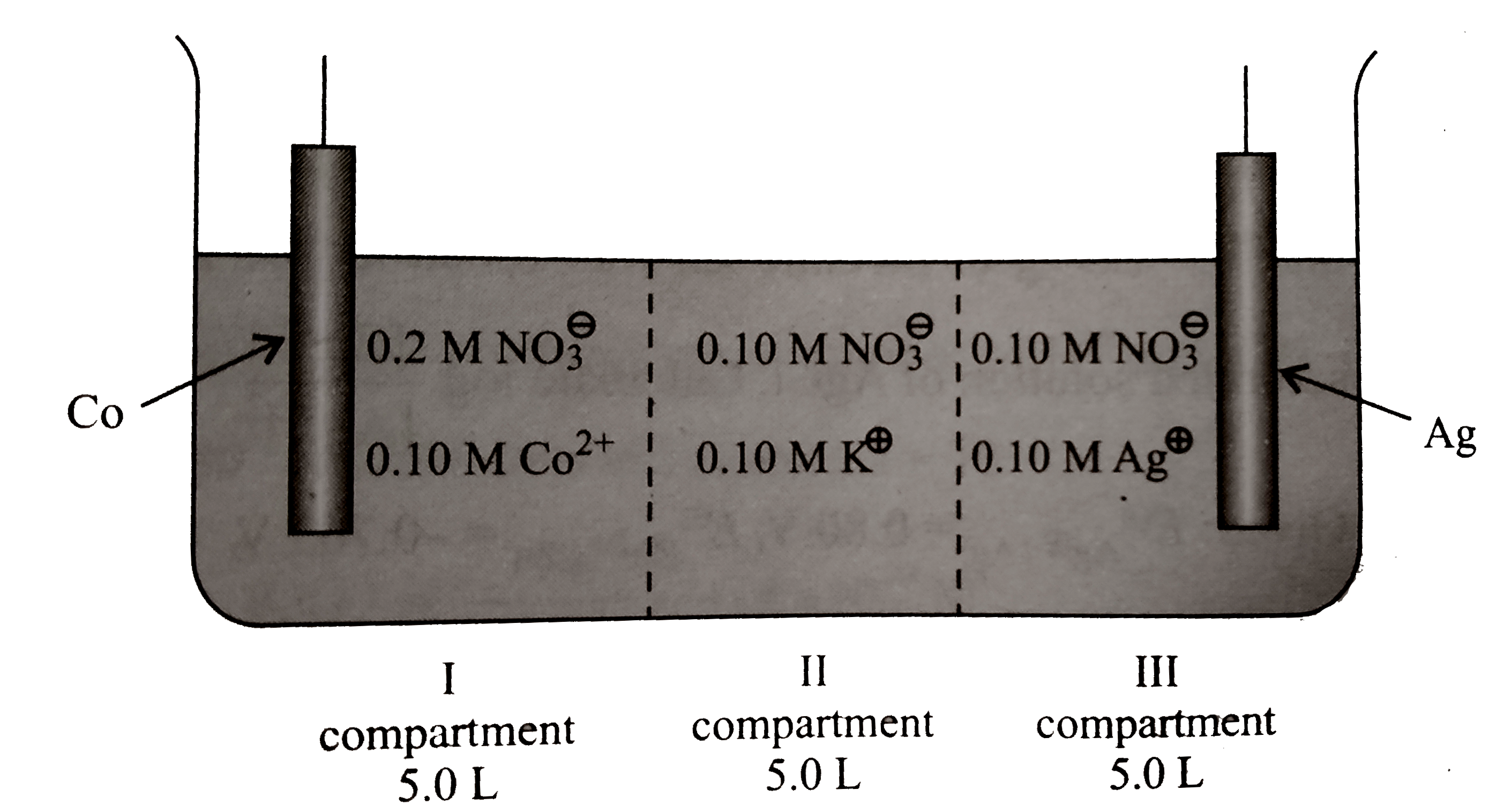
Given :Co2++2e−→Co Ec−=−0.28V
Ag^(o+)+e^(-) rarr Ag" "E^(c-)=0.80V<br>2Ag^(o+)+Corarr Co^(2+)+2Ag" "E^(c-)._(cell)=1.08V<br>Thef∈alconcentrationofNO_(3)^(c-)∈I,II,andIII compartment is View SolutionQuestion 29
A cell, as shown below, consists of there compartments separated by porous pots. The first contains a cobalt eletrode in 5.0L of 0.10MCo(NO3), the second contains 5.0L of 0.10MKNO3, the third contains an Ag electrode in 5.0L of 0.10MAgNO3. Assuming that current with in the cell iis carried equally by the negative and positive ions by passign 0.1F of electricity.
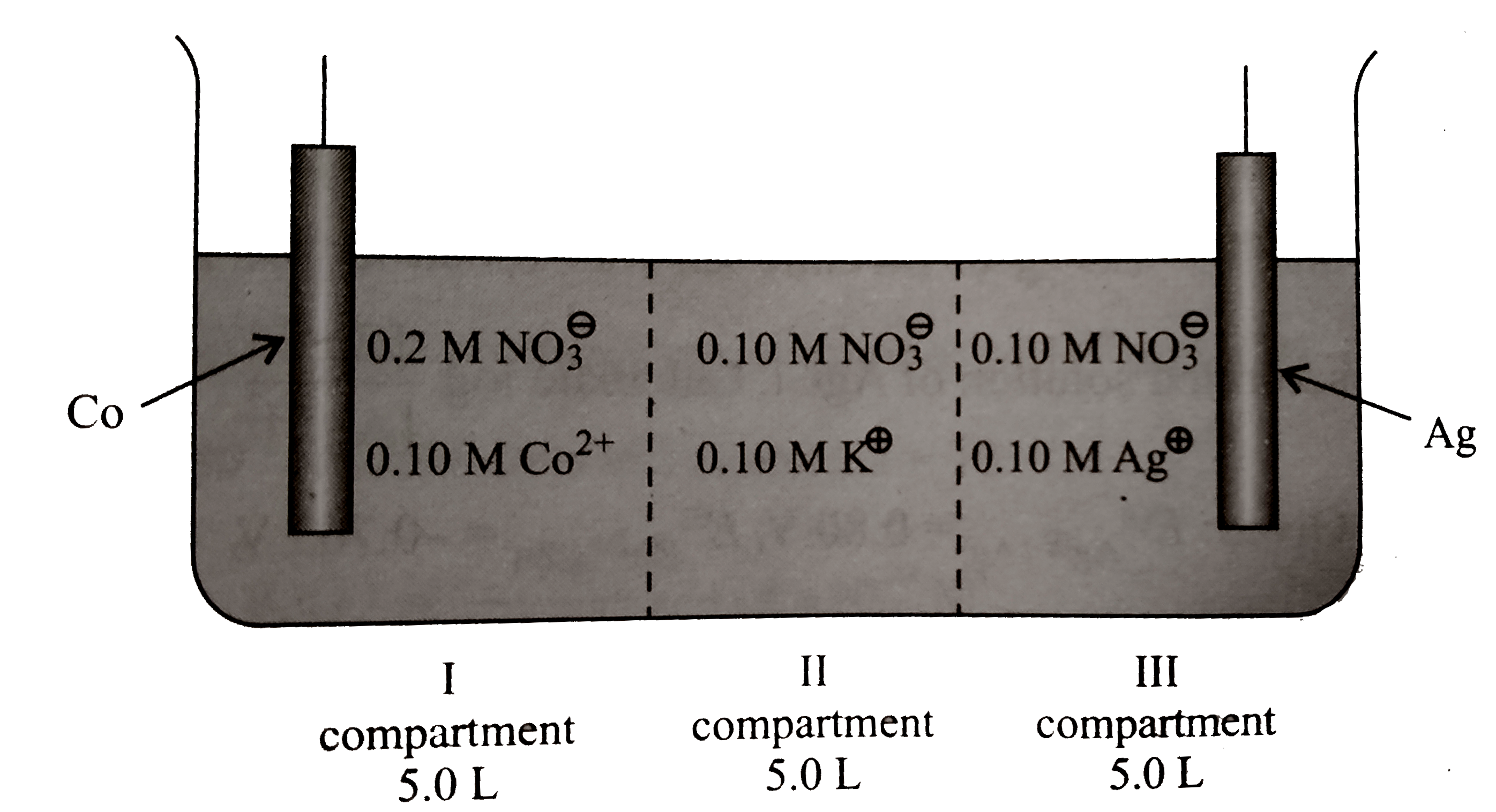
Given :Co2++2e−→Co Ec−=−0.28V
Ag^(o+)+e^(-) rarr Ag" "E^(c-)=0.80V<br>2Ag^(o+)+Corarr Co^(2+)+2Ag" "E^(c-)._(cell)=1.08V<br>Thef∈alconcentrationofK^(o+)∈I,II, andIII compartment is View SolutionQuestion 30
A cell, as shown below, consists of there compartments separated by porous pots. The first contains a cobalt eletrode in 5.0L of 0.10MCo(NO3), the second contains 5.0L of 0.10MKNO3, the third contains an Ag electrode in 5.0L of 0.10MAgNO3. Assuming that current with in the cell iis carried equally by the negative and positive ions by passign 0.1F of electricity.
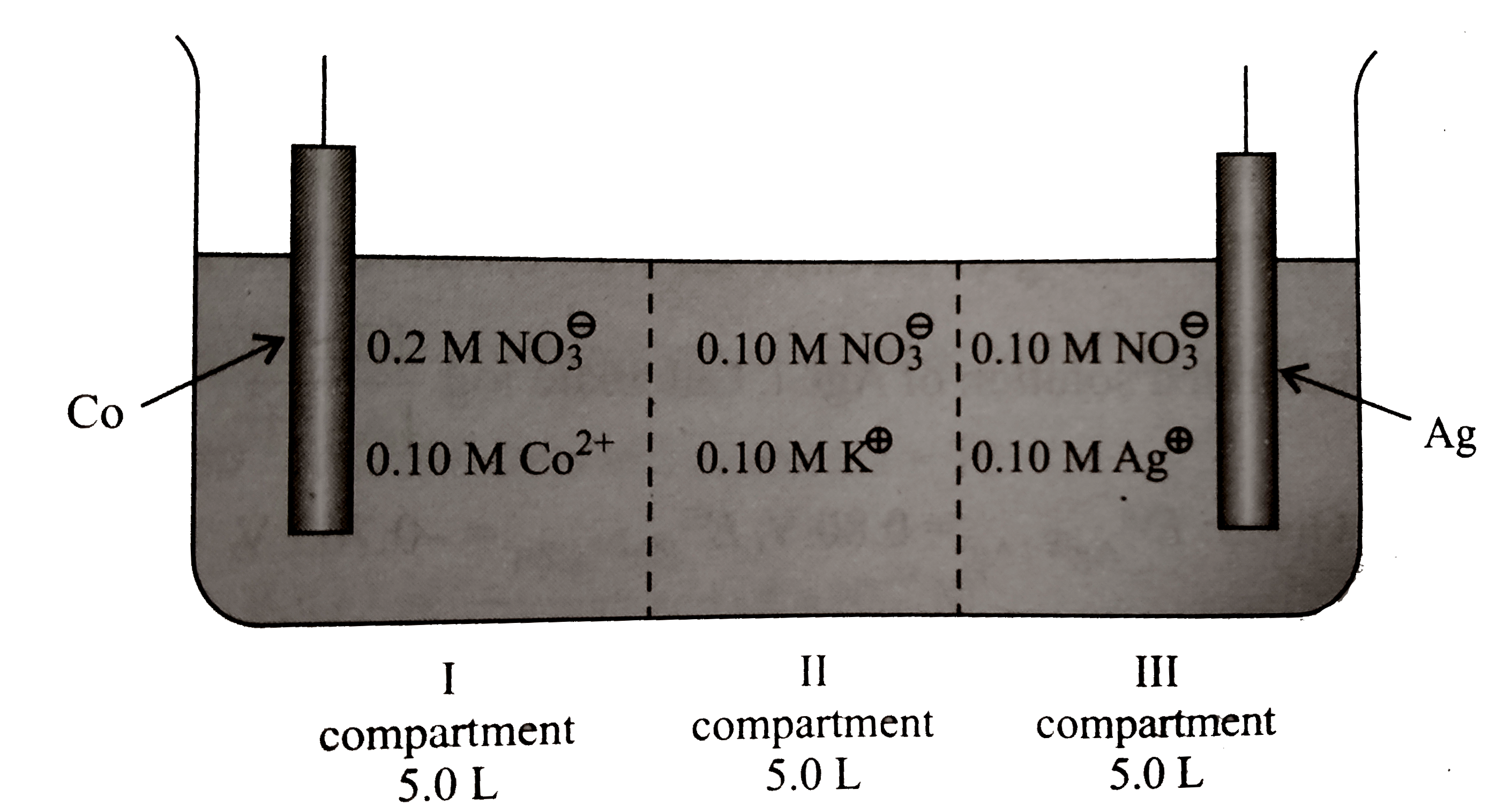
Given :Co2++2e−→Co Ec−=−0.28V
Ag^(o+)+e^(-) rarr Ag" "E^(c-)=0.80V<br>2Ag^(o+)+Corarr Co^(2+)+2Ag" "E^(c-)._(cell)=1.08VThef∈alconcentrationofAg^(o+)∈I,II,andIII compartment is View Solution
All Exercises from CENGAGE CHEMISTRY Class 12 CHEMISTRY ELECTROCHEMISTRY
- Archieves (Linked Comprehension )
- Archieves Fill In The Blanks
- Archieves Multiple Correct Ansers
- Archieves Single Correct
- Archieves Subjective
- Archieves True/False
- Ex 3.1 (Objective)
- Ex 3.2 (Objective)
- Ex 3.3 (Objective)
- Exercise(Linked Comprehension )
- Exerciseassertion -Reasoning
- Exercisefill In The Blanks
- Exerciseinterger
- Exercisemultiple Correct Ansers
- Exercises Ingle Correct
- Exercisetrue / False
- Illustration
- Solved Examples (Electrochemical Cell)
- Solved Examples(Electrolysis And Electrolytic Cells)